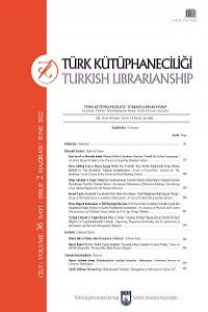Fransa Milli Kütüphanesi ve Türkçe Bölümü
1994'ten bu yana "Bibliotheque nationale de France BnF " olarak bilinen Fransa Milli Kütüphanesi, 15. yüzyılın sonlarından beri kraliyet hazinesi olan kitaplığın « milli» niteliğini kabullenmiş, Derleme Yasası'nın çıkarılmasından sonra da Fransa’nın yazılı kültürel mirasını gelecek nesillere aktarma görevini üstlenmiştir. Ana görevleri toplama, organize etme, koruma ve iletme olan BnF, aynı zamanda, ansiklopedik koleksiyonlar oluşturma ve dünyanın dört bir yanından gelen bilgi ürünlerini bir araya getirme hedefini de izler. Bu hedefe, Türkler ve Türkiye ile ilgili el yazmaları, basılı kitaplar ve gazetelerle birlikte ses, imge ve elektronik kaynaklar gibi materyaller de dahildir. BnF, Fransa'daki en zengin Türkiye koleksiyonuna ev sahipliği yapmaktadır. Ayrıca BnF, çeşitli yollarla hem kamuya hem de mesleki topluluklara hizmet etmeyi amaçlamaktadır. Zengin bir tarihe sahip olmakla beraber, hem kütüphanecileri hem de kullanıcıları bekleyen yeni gelişmeleri karşılamaya hazırlayan BnF’in bu kısa tanıtımının, hakkında daha fazla bilgi edinmek için teşvik edici olacağını umuyoruz.
Anahtar Kelimeler:
Fransa Milli Kütüphanesi, BnF, Fransa Milli Kütüphanesi Türkçe Bölümü
The National Library of France and the Turkish Section
Bibliotheque nationale de France BnF as it is known since 1994, has existed as a « national » library since the late fifteenth century. Soon after, with the establishment of the Legal deposit law, it has assumed the role ofa cultural heritage institution. Along with its main missions which are to collect, to organise, to save and to communicate, it nourishes the ambition to build encyclopeadic collections, gathering the products of knowledge from all over the world, This includes Turkish and Turkey related material, such as manuscripts, printed books and journals but also otherformats, such as sound, image or electronic ressources, to name some. It hosts the richest Turkish collection in France.BnF aims to serve both the public and the professional community by various means. Conscious ofits rich history, it nevertheless, welcomes new developments that await both librarians and users. We hope that this very brief overview willprovide an interest tofind out more about the past and the present ofthe institution.
- Başlangıç: 1952
- Yayıncı: Türk Kütüphaneciler Derneği
Sayıdaki Diğer Makaleler
WoS ve Scopus Veri Tabanlarının Karşılaştırması
Bülent KARASÖZEN, Özlem GÖKKURT BAYRAM, Burcu UMUT ZAN
Fransa Milli Kütüphanesi ve Türkçe Bölümü
Sosyal Bilgiler Eğitiminde İyi Bir Örnek: ABD Kongre Kütüphanesinin Amerikan Hafıza Projesi
Türkiye Okuma Kültürü Haritası
Beyazıt Devlet Kütüphanesi Bülteni
Hollanda’da Görme Engellilere Verilmekte Olan Dijital Erişimli Bilgi Sistemi ve Türkiye’de Durum
